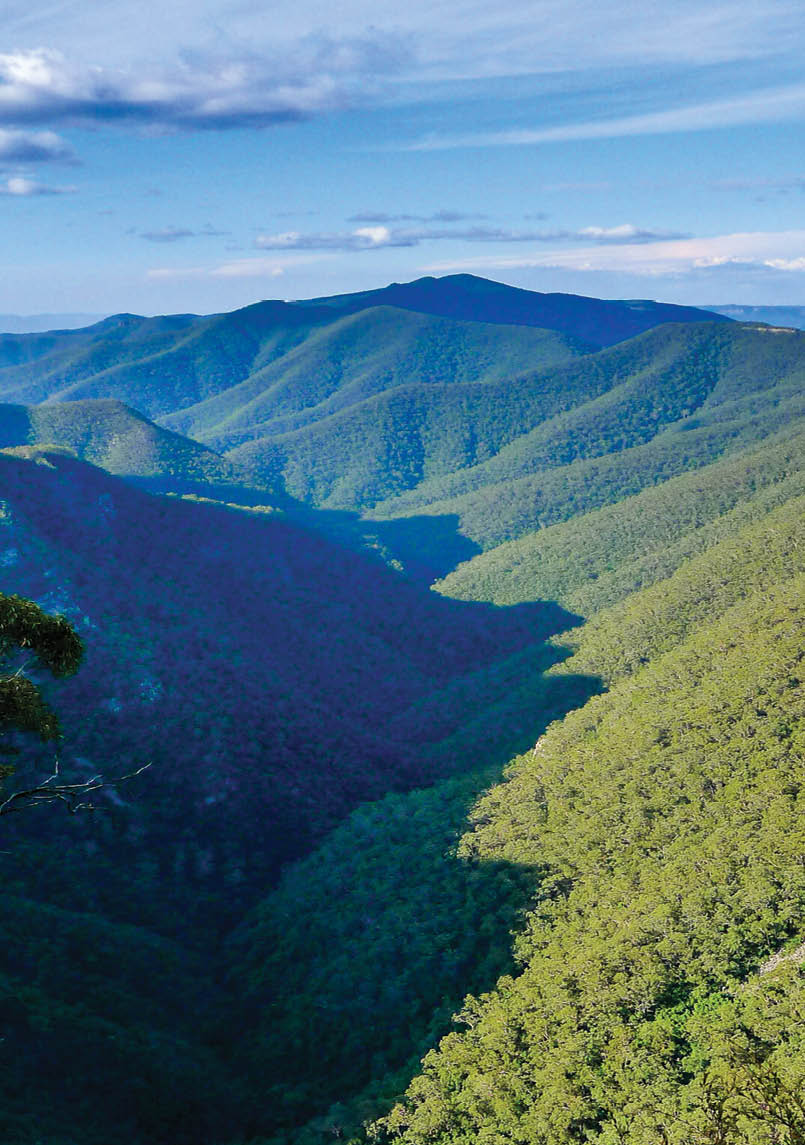


At Victoria’s Point Hicks a furiously barking Australian fur seal, its face torture-twisted, belted up the beach. A 2 am explosion of roaring forties threatened orbit from a Tasmanian south coast Ironbound Range launchpad. And geological, ecological and Indigenous treasures paraded through the sandstone belt oasis of Queensland’s Carnarvon Gorge.
Deep into Kanangra-Boyd NPAll pictures by the author

Waking Up to Wilderness: A Mid-life CrisisCraig N. Pearce

20 | BWA October 2021
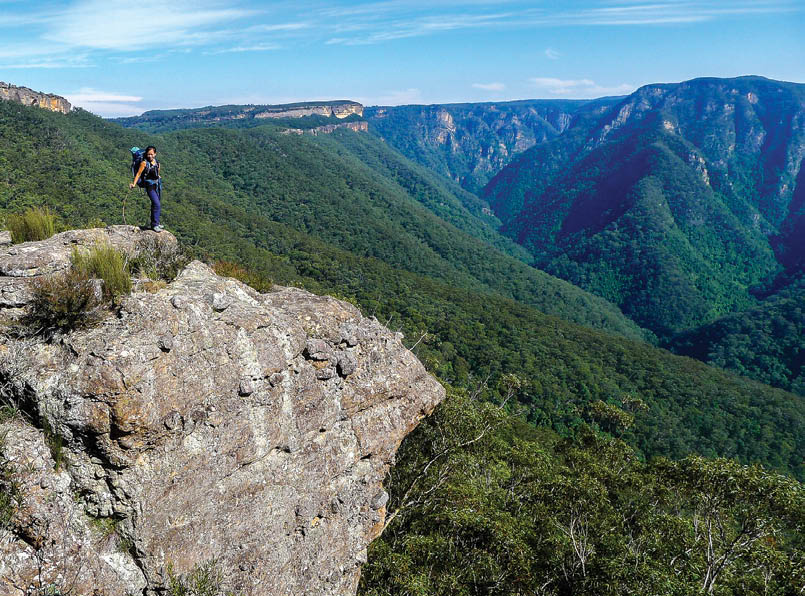

Of all nature’s weapons of mass seduction, however, it is often the cameos that – minutely, stealthily – fire the synapses. Frogs. The great carousers. Perrins tree and eastern stony creek by Kanangra-Boyd National Park’s wild Kowmung River. Corroboree, booroolong and spotted tree in Kosciuszko National Park’s Jagungal Wilderness.
In Kanangra, it was a full-throated rebel yell of rasping, industrial-level noise; choruses in battle one moment, sliding into harmonic, contrapuntal glory the next. In Jagungal, snug in Gungartan Pass’s lee, patches of melting snow feeding rivulets and bog, it was a calmer amphibian recitation. Swells rising and receding; fitful and lullaby-sedating. A connection through croak to nature’s murmured enigmas.
The evening acclamation of frogs in both wildernesses was evidence of their vibrant ecosystems. Frogs have been working on me since I was a child. They are an almost obligatory inhabitant of creeks, that great article of allure to children. Now, on summer
evenings, I get a good carolling from my backyard’s amphibian tenants. Like nature itself, they are full of chiaroscuro mysteries, spawning emotions and resonances as dependable as they are chaotic.
Frogs are a quirk of my Earth experience. Another – about 7600 square kilometres in total, so it’s a big one – is K2K: Kosciuszko and Kanangra-Boyd. Heartlands. Their untamed power, beauty and significance – both feature formally declared wilderness areas, both are UNESCO World Heritage-listed are beacons for how I think and feel about life on Earth.
Happy days? In many ways, yes. But, paradoxically, as I commit myself more to wilderness, I am increasingly angry and despondent about the condition of nature’s gifts we are bequeathing to future organisms, our descendants included.
Kanangra Gorge
“... beacons for how I think and feel about life on Earth.
BWA October 2021 | 21
A mid-life epiphanyThe electrifying, vivid sense of "aliveness" that being immersed in nature galvanises within me materialised as a diamond-cut mid-life insight. Nature’s attractions were always there – making occasional, furtive grabs in life’s back seat. But it was only later (in the "mature years") that all-consuming internal fireworks were ignited.
Literature, the flawed web of human relationships and rock’n’roll have all had their trysts with me, but it is nature that has really given me the full body emotional, intellectual and physical workout. The nature experience – my embracing of wilderness – has in effect become my mid-life rock’n’roll. A typical crisis in many ways as these things go, though perhaps not as sad as the cliched alternatives.
The portal into nature and, ultimately, its prized wilderness dimension, was unlocked by two events. My son being born and wanting him to become familiar with the bush. And reacquaintance with a couple of my past teenage soul brothers – boys truly of the bush. Agrarian Januses?
Back in the day, in those incident-fuelled hometown teenage years, I played farmer by rounding up cattle on horses (trying not to fall off; avoiding snakes). I floated with other harmless troublemakers down the Tumut River on tyre tubes with an onion bag of beer kept cool in the frigid summer waters. I spent lazy afternoons at Little River, doing what many teenagers do and shouldn’t do (kept company by a resident platypus). I undertook no-frigging-idea camping trips up the Goobragandra, chased once by a rabid grazier – whip-cracking, rifle-packing – on horseback down a breakneck gully. All these moments – a fraction of the multitude – conflated into an Arcadia where not a great deal of academic purposefulness transpired.
This action was enacted on the fringe of the Kosciuszko National Park. I was, literally, playing on the edge of wilderness. A typical teenage-child, not divining the
depth lying beneath the surface or, as in this case, beyond the often-kissed but non-consummated littoral.
The portal formally opened when my son and I began joining my not-so-teenage-anymore friends on their Christmas camps on northern Kosciuszko’s Long Plain. Here, there was abundant untouched-by-human-hand wilderness. But so was there an extensive heritage of grazing (ceased a long time back now), and evidence of the Snowy Mountains Scheme. Plentiful nature, but a relatively soft entry.
It was a unique entry, too, as this was horse-camping. In one of the few national park areas where horse riding is permitted, the campgrounds were littered with gooseneck horse float hotels-on-wheels, alongside more rustic means of accommodation. By day, cockies wandered off – limpeted to horses – across frost-afflicted treeless plains and into gnarly scrub-choked hills. At night, around fires, stories were spun. Beer-chilling generators growled. And, as human activity subsided, nature claimed back its placatory prerogative.
These camps – with their bushwalks, horse rides, swimming, cave exploring, yarn spinning and camaraderie – came to constitute the beating heart of nature for my son and me.
The teenage flirtations with nature had taken their next, more pivotal step. An expansion of knowledge and skills took place. Also, without being conscious of it, of ambition, of desire – to go deeper into the wild, to become disconnected from the society of humans which, ironically, is what revealed, then fostered, the desire in the first place.
The mid-life journey was like a revisiting of teenage immaturity, characterised by a need to bust-out, to rebel against the constraints – expectations, accountabilities, habits, routine. It was also a rebelling against the weight and constrictions of (sub)urbanised and corporate regimes – the chain mail of suits and ties. The weight of the built
“... it is nature that has really given me the full body emotional, intellectual and physical workout.
“An expansion of knowledge and skills took place.
22 | BWA October 2021
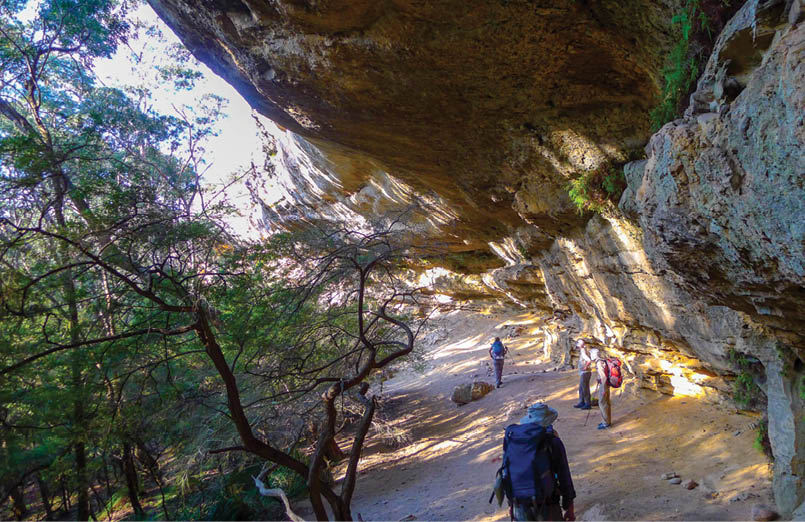

environment, with its buildings, roads and traffic. Its arthritic knots of humans, with their demands around which we must ceaselessly navigate, turning us into distasteful versions of ourselves, was another. It was a package I came to find unutterably wearisome at best, but more often just soul-destroying.
An intrinsic component of this crisis was the examination, then recalibration, of values and priorities. It became crystal – for the first time – that humans are the problem. We are insatiable; our ‘knowing blindness’, wilful greed and destructiveness overwhelming. The surging energy with which I engaged in wilderness experiences was one outcome of this. An escalation in my environmentalism and disdain for humans were others.
The heartlands: old friend, new friend The mid-life construction of Kosciuszko as a heartland was followed by its sister-K – Kanangra-Boyd National Park – becoming a second source of succour, education and influence. Located a few hours west of Sydney, it is an aggregation of deeply incised valleys, towering sandstone walls, secretive waterfalls, the enigmatic Kowmung and sprawling hills cloaked in one of Australia’s signature totems, dry sclerophyll forests. Its
biodiversity, heritage and geology (not least because of its relative proximity to Australia’s largest human population) are of inestimable value.
Kanangra – where the full romantic tempest of nature is on rich display – evolved into being my go-to release valve from the urban zoo. It is remarkable something so untamed is within easy commute of seething Sydney. After a day here, you get a good start on becoming attuned to nature’s rhythms, its eternal descants. No need for talking; often no need for thinking. The primal yearning for atomising into the environment takes over. Its subtle spiritual – and not so subtle physical – massage begins. Sounds, smells, terrain and touch – grappling at rocks and trees; flayed by branches; surfing slippery alarm bell-ringing scree – animating you into a heightened sense of being present in the moment, senses incandescent.
The wildernesses of Kosciuszko and Kanangra-Boyd are the ones I have most often navigated. What they have in common are their climactic extremes and unpredictability. Of the two, counter-intuitively, I’ve experienced more snow in Kanangra and more heat in Kosciuszko.
100 Man Cave, Kanangra-Boyd NP
BWA October 2021 | 23
I’ve been on the high tops of Kanangra’s cordillera in 70 km/h winds, forced down its nuggety ridges to escape their ferocity (and falling branch widowmakers). Another time, I was beguiled by a seeming cloud of pollen, numinous, drifting out of a glaucous dawn – it was baby-flakes of snow. Our tents were frosted cakes in a muted, white-swathed wonderland. Koalas – evident from claw marks on their favoured grey gums – remained unsighted. After the 2019-20 horror fires, surviving populations are scant.
The Kowmung, one of Australia’s few remaining wild rivers, is always a highlight and often the site of a night’s camp. Caves such as 100 Man and 1000 Man even offer no-tent-required hostelries. There are many waterways other than the Kowmung, some of them forging through camouflaged sanctuaries like Morong Deep. A not-so-secret set of eight falls cascade into Kanangra Creek, at the top of the Kanangra Gorge. The views from here exhilarate like few others (and are easily accessible). The bastions of Mount Danae and Thurat Spires glare at you across the plummet. Blue Mountains’ Wild Dogs precinct howls in the distant aether. If pursued, from here one of the country’s great walks stumbles along the stegosaurus spine of the Gangarangs. Traversed are the knolls of Rip, Rack, Roar and Rumble, and the Ordovician period quartzite studded Mount Cloudmaker.
Kanangra-Boyd offers less "soft-entry" points to the outdoors than Kosciuszko. With the former, it’s an abrupt plunge into no-guiderails wilderness; like jumping into an ice-cold waterhole, something Kosciuszko shares in spades. A defibrillating example is the Blue Waterholes, a frequently visited paradise and a jewel of the Australian outdoors. Guarded by Clarke and Nichols gorges, cut through Karst country, and fed by the often underground but here emergent Caves Creek, the holes’ inviting iridescent blue is a cunning deceit drawing you into their glacial grasp.
Away from the madding crowdsBut Kosciuszko, too, once passing through its "civilised" edges, offers extreme opportunities for social distancing. Off-track through the charismatic Jagungal Wilderness, for instance, challenges abound.
Here, bowl-like wolds are thickened with spongy morasses of sphagnum moss, low clutching heath and stumble-inducing clumps of snow grass, exhausting to navigate. Wetlands such as those which support the moss and frogs are the most biologically diverse of ecosystems. Ridges are a bedlam of granite tors. Hills are a rabble of neck-high heath and snow gums, the latter either elegant and brawny or, seemingly, dead – pale, tortured Giacometti arms, fire-crucified spectres reaching hopelessly at a non-existent future. Yet even in this state, they could just be crippled, waiting for lignotubers to sprout. And they provide habitat to fauna, insects and fungi. Eventually, their decomposition will enrich the soil.
Towering, the lion of Mount Jagungal is a guiding battlement, lording over its aspirant flock: anemone buttercup, snow and white daisies, grass triggerplant, bidgee widgee, native edelweiss, alpine pepper, mint bush and gentian, and hoary sunray. Their mosaic illuminates the snow grass-dominated greens.
Both parks are home to many rare, endangered and threatened species, perhaps none more so than the mountain pygmy-possum, the sentimental koala of Kosciuszko (though also a citizen of limited locations in the Victorian high country). With the support of the NSW National Parks and Wildlife Service, it survived the summer bushfires of 2019-20. The only wombat I’ve seen in either park was one scampering over snow in a Kosciuszko winter (though the Kowmung features a teeming urban congestion of their warrens). It didn’t electrocute me into a jolting standstill, though, the way a healthy copperhead snake did, as it sidled towards the unromantically feeling Valentine Creek. Not quite as adrenaline-pumping, but still engrossing, were dingo and yellow-tailed black cockatoo sightings in Kanangra.
“Another time, I was beguiled by a seeming cloud of pollen ...
“... Blue Waterholes, a frequently visited paradise and a jewel of the Australian outdoors.
“It didn’t electrocute me into a jolting standstill ...
24 | BWA October 2021
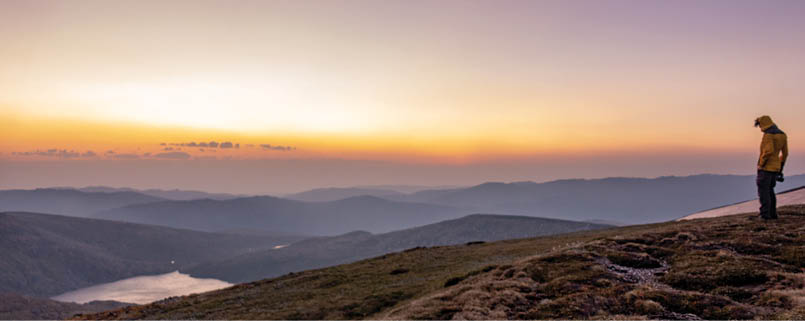

Both parks feature landscapes where ancient geological features, from as far back as the Palaeozoic era 400 million years ago, are still visible. Much of Kanangra-Boyd’s outcropping bedrock was formed then. The signature Kanangra Walls are the western-most part of the Narrabeen Sandstone deposits. They are the outcome of tectonic events associated with the opening of the Tasman and Coral Seas, which resulted in the uplift of eastern Australia. In Kosciuszko, Pleistocene epoch climactic changes are found in the park’s rare glacial and periglacial features, while Holocene epoch sediments and peats hold information on Earth’s post-glacial warming.
As the roof of Australia resides in Kosciuszko, because it offers a greater number and variety of outdoor experiences, and as the views it provides are consistently more dramatic, it is doubtlessly perceived as the more compelling of the two national parks. But it’s also the vastly more visited – by humans. Because of that, and because of the "frog factor" (i.e., a cameo of seduction can transfix as much as its brasher brethren), Kanangra-Boyd offers enough fascinations to render comparisons a waste of breath.
Both parks and their attendant wildernesses possess inexhaustible swirls of enchantment. They vary from the minutest – branch-draping lichen, a shabby filigree – to the grandest – the Western Fall, yawning and vast, plummeting from rugged knuckle eyries like the Main Range’s Sentinel. They boast a share portfolio no sane person would want to cash in.
Opposing corners: city vs natureOccasionally, I think back to the time invested into nightclubbing, art and architecture. New York, Berlin, Hong Kong. Rock’n’roll games. All those missed backcountry walking opportunities.
A corollary to this mental trajectory is reflecting on what would I now rather wake up to? A solid, silent, safe ceiling? Or an inky blue-blackness littered with the flickering glitter of stars? A screech-fest of rainbow lorikeets, another of nature’s non-human narratives, to eavesdrop on? A percussive havoc of branches, foliage and wind? All attune me to Earth’s fervid throb, its intoxicating humid breath. Unfathomably complex, and with such a pageant of tales to tell! Their unfurling is ready for a receptive human heart, but by no means waiting for one.
Did humans build society and cities to escape from themselves, to escape from having to interact so closely – symbiotically – with the natural world? In society, there is an expectation to conform, to suppress our natural character, to acquiesce to the ‘establishment’. Depending on our economic and social standing, this can lead to a pinched, meagre existence.
The ties that constrict Cities, in theory, are an enabler for humans to have longer, happier and more fulfilled lives than they once achieved. They are generally successful in securing the "longer" ambition. It seems, however, cities and society are as dictatorial and enslaving as much as they are a platform for acquiring happiness and fulfilment.
“... the views it provides are consistently more dramatic ...
Smoke-tinged dawn over Blue Lake, Main Range, Kosciuszko NP
BWA October 2021 | 25
It is unlikely significant numbers of people will again seek to settle permanently in greater intimacy with nature. This is despite cities offering an impoverished, clinical and anesthetised actuality, contrasted to one that involves a higher degree of engagement with nature. The growing numbers of people visiting national parks, however, indicate a snowballing enthusiasm for (and hopefully a devotion to saving) nature. Why, then, the junkyard of discarded oxygen cylinders on the way up Everest? Or the coagulation of human detritus I encountered when traversing wilderness areas along the remote eastern-most coast of Victoria and southern-most coast of NSW? Even when theoretically loving the wilderness, it seems, humanity’s rapacious, dirty hand cannot help itself.
Once, the establishing of society may have saved us as a species. Now, it clearly seems to be destroying us. Advances in science are allowing more people to live, and to live for longer. This is exerting more pressure on planetary resources, including land on which to do this living. Here, the simple laws of supply and demand come into play. They are magnified by human ego, a default of which seems to be wanting more than its neighbour. This is a defining trait of our species, one the Bible warned against.
I don’t see "going back to nature" as a regression. In fact, I think there is a strong case to assert humanity came to a fork in the road, took a certain path (let’s call it the mass destruction of life on Earth path), then realised, oops, maybe we took the wrong option or, at least, went a bit too far down that path and we need to backtrack a bit, look for more of a happy/sustainable medium (I’m thinking of Graeme Base’s Uno’s Garden (Picture Puffin, 2013) – a philosophical treatise on the human species co-existing with nature), where we can still be cossetted by some of science’s advances, but not despoil nature to the extent where its beauty is lost and, at its apogee of disaster, the planet’s ecological balance is so ruined that life on Earth cannot survive.
An outcome of this might be a compromise in cossetting – less of those near-fundamental modern life hallmarks of streaming, fast food and aeroplane trips. It may also lead to a halt in life expectancy’s lengthening. And without doubt it must result in zero population growth.
The nourishment of natureAs I’ve stepped into a multiplying number of nature’s wild domains, I’ve found them to be more potent and nourishing than humanity’s built environments (the latter striking me as dissociative and corrosive). Nature possesses, and represents, life in a fuller, more realised manifestation. It repairs and nourishes. My journey towards nature has occurred in parallel with the increasing celerity of my anti-urban journey. The grind of combative/passive-aggressive corporate life takes its toll. The accumulating recognition of humans’ destruction of life on Earth takes its toll. And even though I have become more and more attuned to wilderness, and have been calmed and revitalised by it, my pessimism and negativity regarding its future is becoming debilitating.
At the core of this pessimism is humanity’s impact on nature; its tyrannical behaviour in claiming Earth as its property alone, unable to acknowledge there are sentient creatures on the planet who are also entitled to feel it is their home. As well as being life-affirming and enthralling, then, my immersion into nature has also caused me pain. It provides the positive and the enthralling. Yet, at the same time, it crystallises much that the human species is doing to destroy life on Earth, and as such its fundamental self-centredness.
Humanity’s approach to nature (and its many non-human organisms) is reminiscent of European imperialism, with its concomitant demeaning and destruction of civilisations and lands outside its own domain. And there is also humans’ lack of recognition of narratives that non-human animals might cherish. We know how intelligent dolphins, elephants and pigs are. We now know that mice, for instance, have a repertoire of emotions. And we have been aware for some time of plants’ social and communicative abilities: the ‘wood wide web’ (the term coined in 1997 by the scientific journal,
“ ... it seems, humanity’s rapacious, dirty hand cannot help itself.
“I don’t see "going back to nature" as a regression.
26 | BWA October 2021
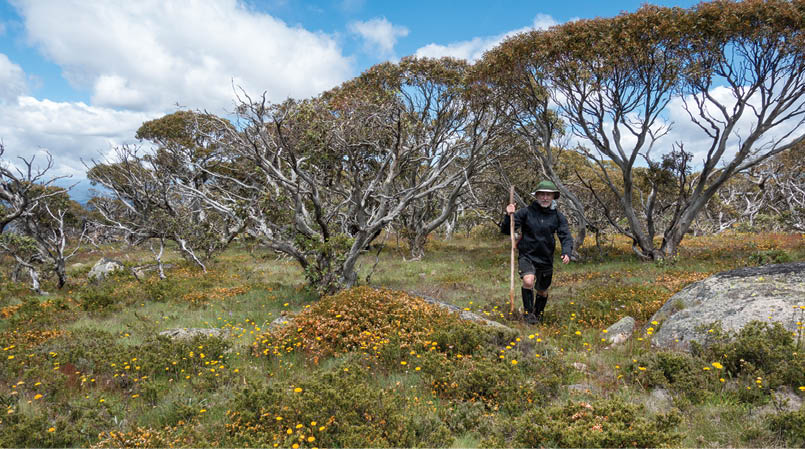

Nature, when publishing forest ecologist Dr Suzanne Simard’s research). It is comprehensively deflating to see humans’ disrespect towards these realities and the resultant impact on organisms themselves.
The hollow slogan of economic growth"Growth" (economic, cities, individual wealth) seems more important to humans than anything else. This obsession, perhaps the most heinous human transgression of all, is the fundamental reason for life on Earth’s diminishment and prospective extinguishing.
Economic opportunity equalisation, not economic growth – with all its attendant digging up more, building more, producing more, consuming more – is what will better serve the human species, as well as other organisms. The proposition that economic growth helps the poor become wealthier is, for the most part, a fallacy. Economic growth mainly leads to more wealth for the well-off and continued marginalisation of the less well-off (as well as more environmental degradation).
Growth is a synonym for taking – for, fundamentally, greed. It says to hell with the Earth as a whole and what we are leaving for our descendants and/or the impact we are having on non-human lifeforms. Only a miniscule number of us are innocent of this charge.
Anyone who has more than two children is guilty. Anyone who buys cling-wrapped bananas is guilty. Anyone who uses energy created by the burning of fossil fuels is guilty. Nearly all Australians have superannuation which is investing in environmentally damaging companies. Guilty.
There are, plainly, degrees of guilt. It is politicians, large businesses (especially those generating fossil fuel-driven energy) and investment entities that carry the greatest accountability. It is they who can have the biggest impact on our way of life and, hence, environmental impact. That’s where the rubber really hits the road. But this truth does not obviate us of our own accountabilities. Any of us who vote, who invest, who consume…are making choices now. Are they the best choices for our planet?
Wild walkingThe most fulfilling way to experience, and benefit from, wilderness is to journey through it. Ideally propelled by foot, but sometimes by raft or kayak, or even bicycle. Testing its littoral doesn’t cut it. One reason for this is the physical demands of a multi-day trek. There is the psychological dimension, too. In the wilderness, they have a propensity to entwine and accelerate a loosening of your mind from its moorings. The physical sense of freedom instilled underpins the consequential mental freedom.
The alpine expanse of Mount Bimberi, on the Kosciuszko side
BWA October 2021 | 27
While any wilderness interaction is worthwhile, for a tangible and rarefied transformation to materialise, a walk of at least four days feels obligatory to me. Over this duration, an intimacy and bond form. Both you and nature give up secrets – a confessional. Free psychological counselling. You live in the moment of travel, water, food, safety, shelter; but there is the alternative psychological reality, too. Deliberate reflection or wayward reverie? Sometimes you are bound to the present, fully in the moment. Sometimes you are simply "gone", freewheeling into a deliciously unencumbered flight of fancy. (Just be wary that enough alertness is activated to not trip over a tree root or step on a snake.)
As Robert Macfarlane implies in his Underland (Hamish Hamilton, 2019), nature and geology can work as a portal (that word again) into less explored recesses of our lives. An "opening up" transpires, into the "other" – founded on or circumscribed by its metaphysical, physical or sensate facets – into something more capacious, a cosmos of stars, meteors, coruscating solar gales – our breath. A lucid and indescribably personal presence.
The wild offers an alternative to our species’ now dominant – screen-afflicted – blink of an eye attention span, which has somehow managed to position itself as desirable. Nature rewards the patient, those willing to soak in it. It is anti-superficiality. Anti-artifice. Sometimes the best of nature is immediately apparent but, nearly always, depth and dimension will be revealed over time, as you allow it to become part of you, and you of it.
Perhaps the greatest challenge wilderness presents when encountering it is that, released from the relentless distractions of urban life, we are forced to live closer to ourselves, confront and wrangle with who we really are. There is no hiding. This necessitates a degree of bravery we are not well-versed in practising.
Cities foster a sedentary mode of living, whereas humans, Bruce Chatwin’s postulates in Songlines (Jonathan Cape, 1987), were designed by natural selection for “a career of seasonal journeys on foot …” In Songlines he quotes one of Dostoevsky’s characters, saying that man, originally, was a “wanderer in the scorching and barren wilderness of this world”. There is some irony in this, as when I think of what most accurately describes ‘barren’, it is cities, rather than anything relating to nature. Nature’s wildernesses are, to me, abundance incarnate next to the sterility of cities. (Rather the solitude of the bush than the loneliness of a city crowd.)
It is a notion that helped justify Chatwin’s peripatetic existence, but one of Songlines’ themes is that movement, walking and nomadism results in vigorous health. Whereas stasis, ultimately, leads at best to inertia and dissipation – despite psychiatrists and politicians, among others, demonising the “wandering life” – eastern thought preserves …“the once universal concept: that wandering re-establishes the original harmony which once existed between man and the universe.”
Intrinsic to the demands of multi-day wilderness walking is its physicality. 14 to 24 kilogram backpacks. On-track and (smashed) off-track. Treacherously uneven, tree-barricaded, torrent dissected, mudhole-punctuated routes. A quad exploding, cardio-bursting up; a knee-brutalising down. The micro muscles this sort of exertion employs makes it a sadistic – but perversely exhilarating – a high-intensity boot camp session. There is no equivalent. It’s a cauldron of sensory overload. Every fibre in your body – from feet to fingers to scalp – comes fiercely alive. It is full-body physical engagement.
To put yourself through challenges like this clearly requires a love of adventure and an appetite for, and an ability to find solace in, suffering. It is an inseparable part of the package. You are compelled to live life more
“... nature and geology can work as a portal ... into less explored recesses of our lives.
“... we are forced to live closer to ourselves ...
“Treacherously uneven, tree-barricaded, torrent dissected, mudhole-punctuated routes.
28 | BWA October 2021
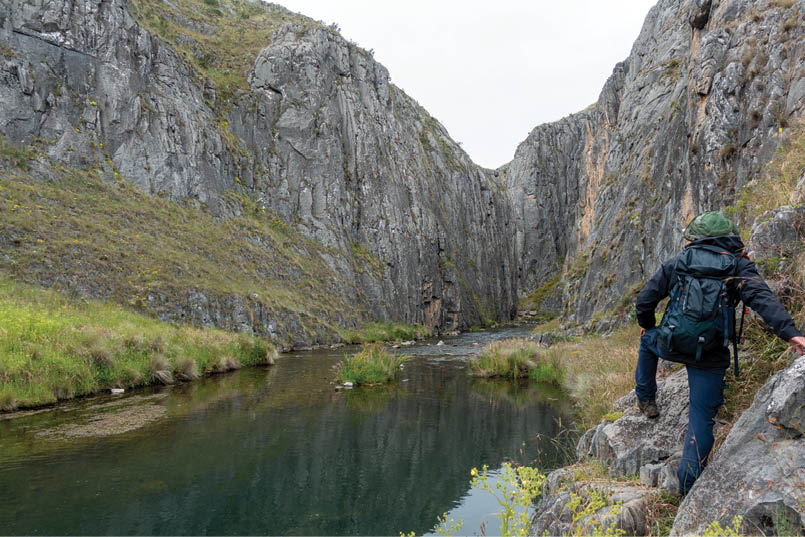

fully – physically, intellectually, sensually – compared to feeble urban existence. The outdoors experience delivers its own sort of equipoise – a hunger for endorphins released by its physical aspect, balanced by the serenity replenishing our mental and emotional faculties.
An ingrained joy every experience in the wild provides is its unwavering provision of the new, something not previously encountered, either individually or in combination with other factors. Weather, river/tide heights, animals, sounds (birdsong, wind rifling through foliage, waves - a soft slapping, a booming thunder), seasonally or weather-impacted vegetation (e.g., a rock orchid, a freshly fallen tree), unencountered routes (I’m well qualified in unintentionally discovering off-piste routes - just don’t mention the "lost" word …). Often, it is simply that, for the first time, I "see" things I have wandered past many times before.
It is a paradox that while in the city I crave separation and silence – oblivion from its rebarbative static, from the way its version of living seems so sensorially reductive and yet so wound up in mind-numbingly beige complexity – yet wilderness’s 4D
sensual surfeit flicks a switch to maximum animation. The demands on others that people and bureaucracy make are enormous, asphyxiating, as is the city’s furious busyness. The cramming of so many humans in such confined spaces, nearly all of whom do not know each other and have minimal tolerance for each other, has become alienating, even repellent.
Wilderness, however, despite it churning with both life and the inherent violence of survival, also possesses a soothing spaciousness. Its version of busyness is a balm, rather than a weight. It provides that much sought-after separation. And an enhanced possibility of an easy, intimate connection with Earth itself.
The inheritance “Wilderness begins in the human mind,” wrote Edward Abbey (Desert Solitaire, McGraw-Hill, 1968) who has been part of the chorus claiming the idea of wilderness is, as Wallace Stegner put in his Wilderness Letter (1960), “a resource in itself” – an “intangible and spiritual resource.” It is an opportunity, too, Stegner wrote, to help us understand, “we were in subdued ways subdued by what we conquered.”
Clarke Gorge, Kosciuszko NP
BWA October 2021 | 29
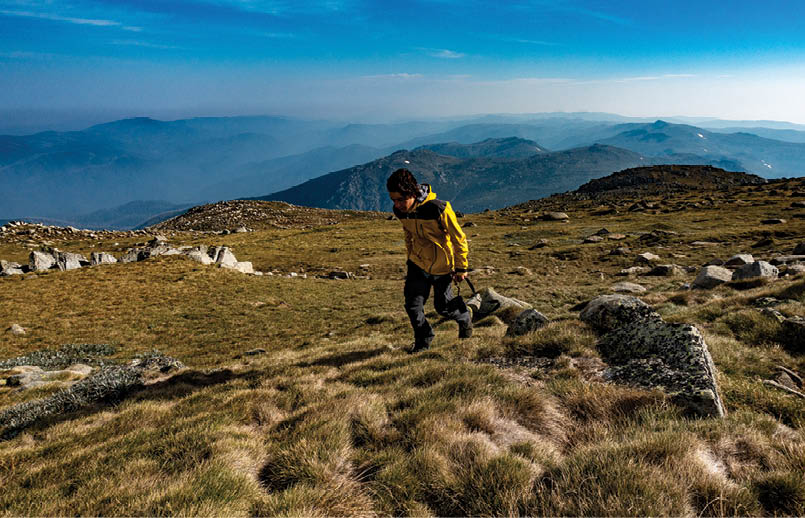

In other words, we don’t need to visit wilderness to get value from it. Other than its qualities of oxygen generation and biodiversity storage that are necessary for our survival, it is a source of our sense of belonging, our sense of hope, our sense of the dynamism and diversity of Earth. It feeds into our imagination – a foundational element of the joy we feel from being alive. It should also tell us something about where, as a species, we came from, what our mistakes were and what we might be able to do to ensure the planet’s health.
For me, however, while the knowledge that wilderness exists provides inspiration, it is being immersed in it when I comprehend its vigour and profound value. This is when its cathartic and life-enriching characteristics saturate with their irresistible authority. It has worked on me emotionally, psychologically, physically and politically – ingrained within every cell of my body. Too long an absence from wilderness feels like being manacled (resentfully, to the city). Strength leaches away. Unshackled, it is an invigorating dive into an icy tarn.
It is also humbling, as the deeper into its folds you venture, the greater the perspective you acquire of humans – individually and technology-unencumbered at least – being motes of dust in a maelstrom. As we have chosen, as Stegner put it, a “headlong dive into our technological termite-life,” (and this was written pre-digital in 1960 …), it is shameful we have harnessed science and technology to so thoroughly debase the natural world.
Plant neurobiologist Stefan Mancuso puts it bluntly. Homo sapiens, although only having been extant for 300,000 years, when the average lifespan for a species is 2-5 million years, “… have been able to almost destroy our environment. From this point of view, how can we say we are the better organisms?” A little humility would do our species (and Earth) a world of good.
Despite this determined march to wilderness extinction, and the bushfires of 2019-20 doing their best to eviscerate them, I still have my K2K heartlands. Hopefully, their ecosystems will recover to some semblance of what was there pre-fires. But even if
Windy morning on Mount Twynam, Kosciuszko NP
“Too long an absence from wilderness feels like being manacled ...
“A little humility would do our species (and Earth) a world of good.
30 | BWA October 2021
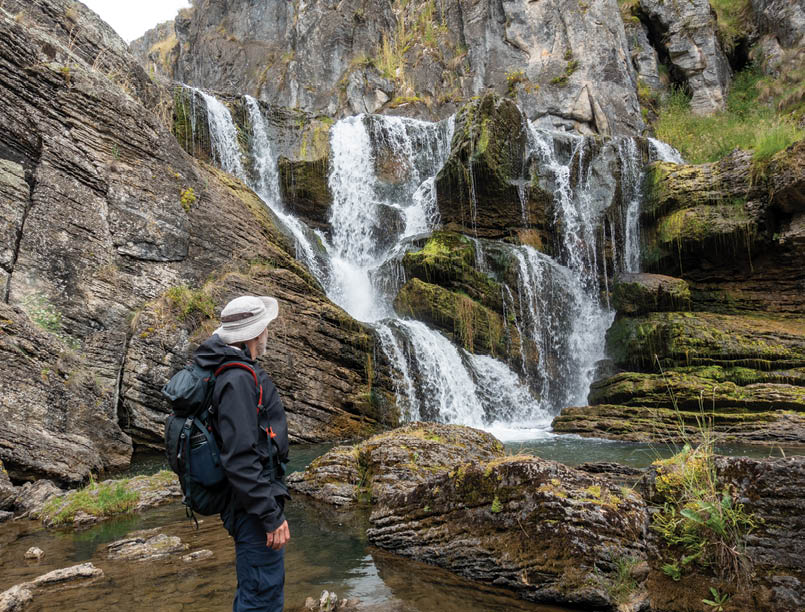

Cooleman Falls, Cave Creek, Kosciuszko NP
they do, like all of nature, their future (and humans’ future) remains under threat from anthropogenic climate change – founded on damage being caused by what Naomi Klein calls “fossil fuel profiteers” and their “enablers in government”.
Thinking big-picture and strategic about climate change sounds grand. But it is the sometimes small, transactional steps, doing something, not talking about it, that makes a difference. Execution not abstraction. Each company, each investment entity, each tier in the hierarchy of government, each human being. A flourishing wilderness and the survival of life will only result if all participants in the dance fulfil their role. Each step executes not only a material outcome in and of itself, but it also contributes to a momentum that might just encourage others to join in. It should be unacceptable, and be perceived as unacceptable, not to do this.
If this occurs and, crucially, only if this occurs, then my small friends the eastern stony creek, corroboree and booroolong frogs will have the opportunity to thrive. As pivotal constituents of wilderness, they will then be able to continue beguiling those humans – our children, and their descendants in turn – intrepid and fortunate enough to enter the frogs’ cloistered, sacred neighbourhoods. This will help realise, as Stegner put it, “the geography of hope.” He wrote this 60 years ago. I am sceptical such hope remains warranted. What choice, however, do we have? As without hope, we will lack the motivation to take action. And only action, and the change that instigates, will result in a healthy planet and the retention of its devastatingly beautiful wildernesses.
“Hopefully, their ecosystems will recover ...
“... the geography of hope ...
BWA October 2021 | 31